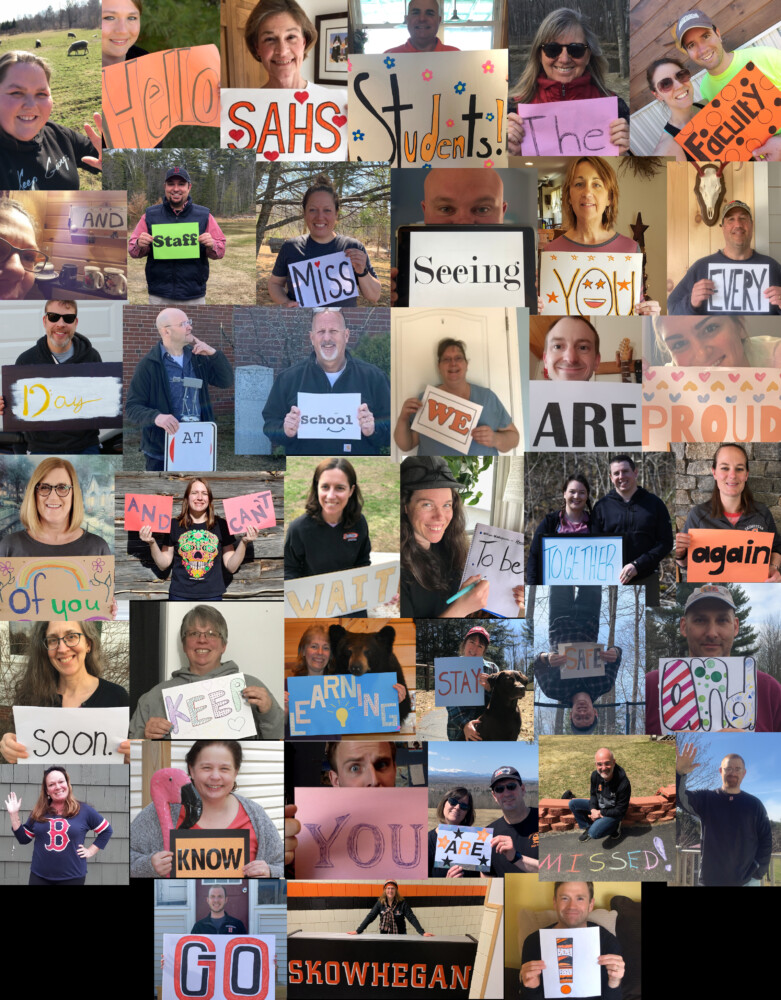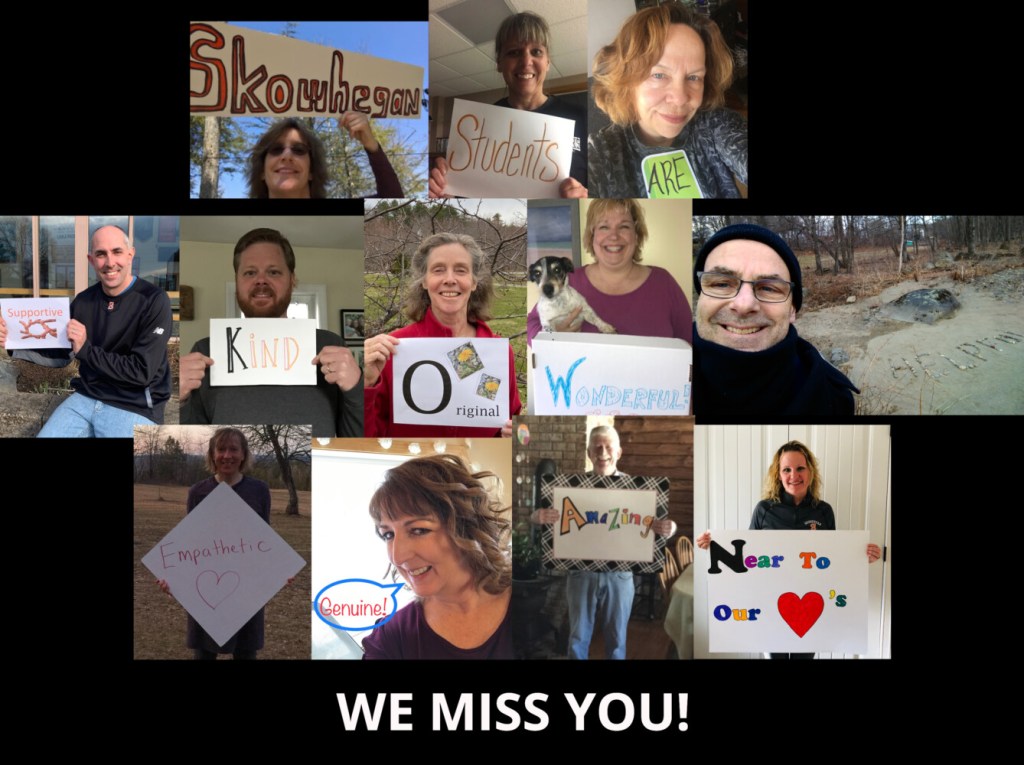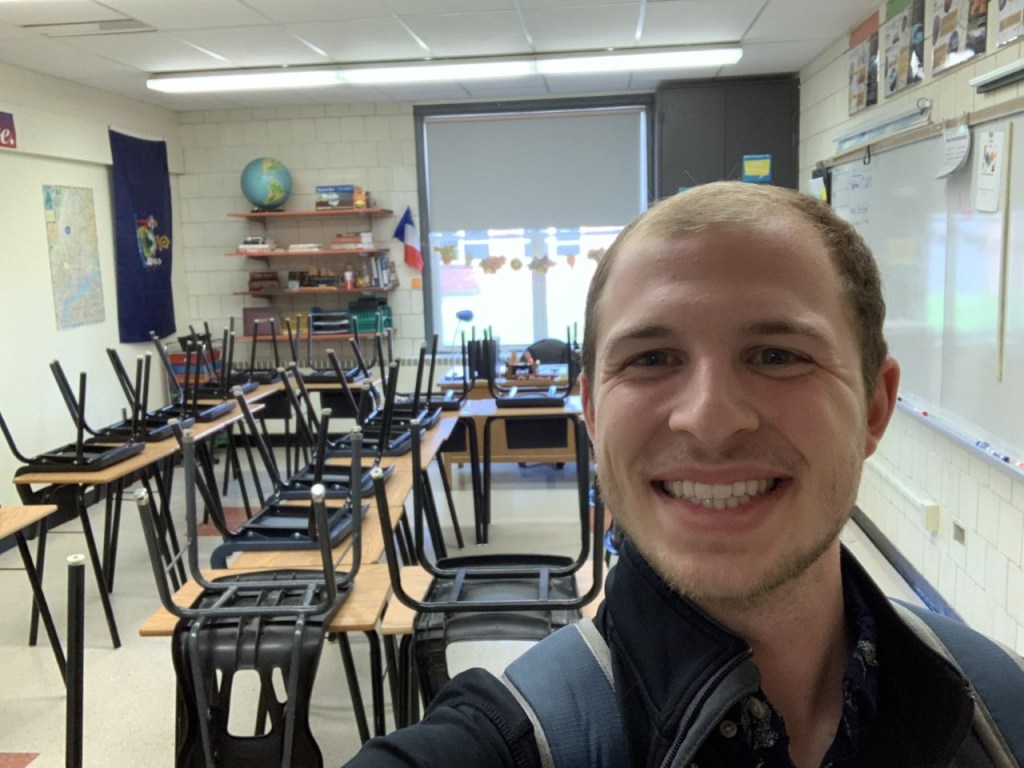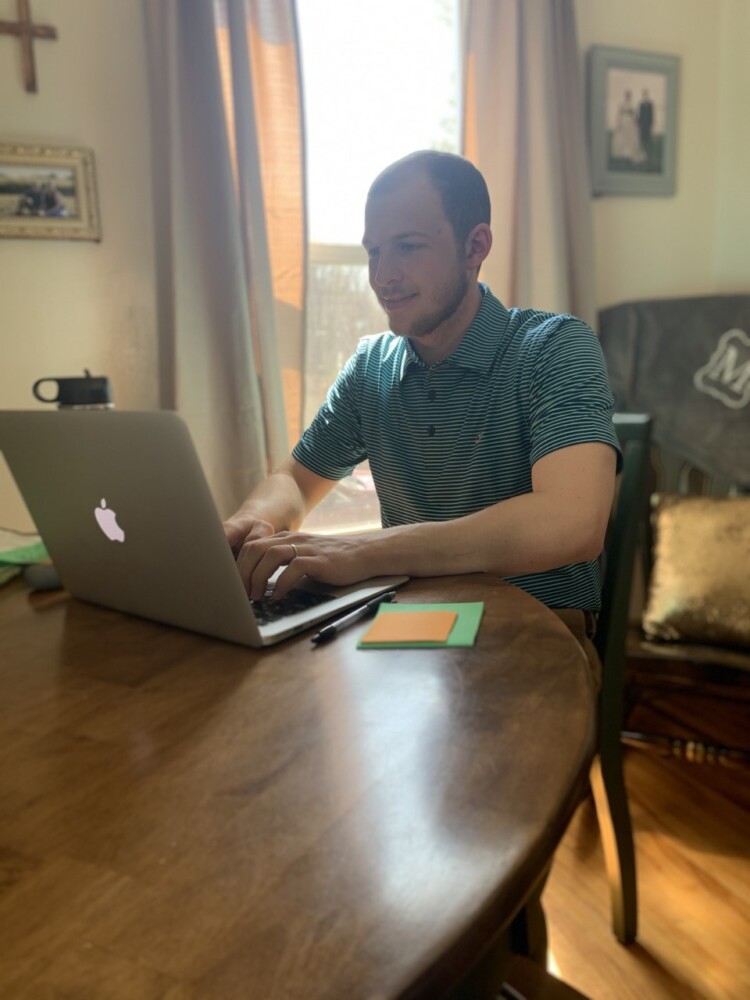Over a month after school buildings were closed because of the coronavirus pandemic, teachers at Skowhegan Area High School, like so many others, have been working around the clock to provide educational resources to their students and remain in touch with them while maintaining their own lives within the confines of their homes.
Skowhegan Area High School, which serves about 700 students in Canaan, Cornville, Mercer, Norridgewock, Skowhegan and Smithfield, closed down in early March in response to recommendations from state government and health care professionals to stay at home, wash hands and observe social distancing.
Principal Bruce Mochamer said, “We are facing new challenges everyday, juggling family commitments and school expectations at the same time and in the same space, and that is not easy.”
THE HARDEST PART: SEPARATION
During the first two days of school closures, teachers gathered at the high school to put resources together for students and to brainstorm ways to keep their students engaged.
“Us teachers went back on Monday and Tuesday of that first week to go back to the drawing board,” said Isaac Michaud, a first-year teacher at the high school. “We spent those two days working on packets of materials to go home to students.”
Michaud, who teaches ninth grade geography and 11th grade U.S. history, said that during these “packet-making parties,” the teaching staff was able to make more than 800 units, enough for every student covering every subject, including gym class. The packets are available at the school and online and can be handed out during meal deliveries.
“Every department had something that we wanted delivered,” Michaud said.

First year teacher Isaac Michaud came up with the idea to create collage messages to students so that Skowhegan Area High School teachers who wanted to take part could send them a message. Michaud has also created Tik Tok messages as well. Courtesy of Isaac Michaud
Ryan and Rosemary Libby have taught at Skowhegan Area High School for 14 years. Rosemary, who teaches English to ninth and 11th graders, and Ryan, who teaches algebra to ninth graders, said that while shifting to online distance learning, they have had to tackle new obstacles: teaching their students online while raising a fifth grader who is also learning remotely and raising a toddler at home who would typically be in day care.
“It’s very tough and extremely difficult, but we have felt fortunate to have an administration that has always believed in family first and I take a lot of stock in that,” Rosemary Libby said.
Through all of their years of teaching, the Libbys say that there has never been anything quite like this that teachers and students have had to face.
“Last year we dealt with gun violence threats, and previous to that about 12 years ago, we had a lot of bomb threat evacuations, but those were all so distinctly different because they were about you facing challenges with your kids and dealing with classroom disruptions together and getting through these times of uncertainty with each other in the room. This is really unprecedented, that we’re cut off from one another.”

Teachers Rosemary Libby, left, and husband Ryan of Showhegan Area High School, pose Wednesday with their children, Tessa, 10, and Ada, 1, at the family’s Skowhegan home. Morning Sentinel photo by Rich Abrahamson Buy this Photo
All three teachers said that the hardest part about working remotely is not being able to see their students. They have gone from seeing each other for several hours every day to seeing some of them weekly through online Zoom calls.
“It’s devastating,” Rosemary Libby said. “Everything sort of just stopped in its tracks, and we’ve started to wonder if we’re ever going to see these kids again. We’ve really cut their experiences in the high school short, and we wonder if they’re going to experience the rest of their school year and what it will be like.”
Michaud decided to start making TikTok videos to reach his students at home. His first video portrayed him and other members of the social studies department sending a message to their students that they were missed. As this idea started to gain traction, he said more teachers became interested in taking a part in the messages being sent out.
From there, Michaud came up with the idea to create a collage of photos of each teacher holding an object or standing near one that contains a single word. The individual photos are added to the collage in an order that creates a sentence that conveys a message that all the teachers wanted to send.
“It was an easy way for us to get the message out to our students and communities,” Michaud said. “We had to make two collages because there were over 50 teachers that wanted to be a part of it. I wasn’t expecting that much interest. It was really good to see.”
Teachers are expected to touch base with their advisory groups weekly through email, phone calls, text messages or video chats. Initially, this was to make sure students were OK, that they were eating and to see if they had online access. As time has passed, it’s become more of a social opportunity for both the student and the teachers.
“The point has mainly been about wellness,” Rosemary Libby said. “We are social creatures, and these kids have gone from seeing us and each other every day to never and living in quite a state of isolation. It’s been kind of a heartbreak to realize that some of our students are home by themselves helping their younger siblings learn and to continue their own learning because they have parents that still work. The burden is really heavy for some of our kids and that is a really heavy thing for me to think about.”
TWO MAINES
“For me, learning the technology wasn’t the difficult part,” Ryan Libby said. “It was the complete mind shift that you had to be constantly engaged in outlook meetings and Zoom meetings. Changing from the classroom to Zoom is so unbelievably awkward. The kids stare at you through a computer screen not knowing what to expect. To have me on a webcam trying to make something entertaining is just not going to happen in an algebra setting.”
Michaud said the transition has not been as difficult for him because of the way he teaches his classrooms in a normal setting.
“I grew up and continued to do my education with online stuff, so I know how to put together a class website, to run these Zoom meetings and different things which I think has helped me to not be as nervous,” Michaud said. “I’m kind of put together because I already had a lot of online stuff and a presence. My geography kids already had a class page where we were doing things already.”
@themrmichaudI miss my students! Get this on their ##fyp so they know they are missed ##bored ##foryou ##teacher ##teachersoftiktok♬ Bored in the class – alecmichaeldood
Assistant Superintendent Jon Moody said in an email on Tuesday that though the information is not yet complete or as accurate as the administration would like, Somerset County data indicates that about 73% of people have broadband access. Though that number may seem high, Moody said that many families often do not have the devices needed to connect online or have only one device to share with multiple students.
“The challenge of ‘access’ for our students is likely much greater than the roughly 30% who lack connectivity would suggest,” Moody said. “Additionally, when we called, we had many families report that they had access through their phone, which really isn’t ideal or sustainable for online remote learning.”
“In talking with educators from around the state,” Moody said, “there really are two Maines: areas that have the ability to have broad, universal access to high-speed internet, and those that simply don’t. Our administrators believe that the combination of factors could lead to as many as 40%-50% of our students not having ongoing regular access to high-speed internet.”

First year teacher Isaac Michaud came up with the idea to create a collage of photos of teachers from Skowhegan Area High School with each holding a word arranged in a sentence to deliver a message to their students. This is the second of two such collages that were created and sent to students through email and posted on the School Administrative District 54 website. Courtesy of Principal Bruce Mochamer
EDUCATIONAL EQUITY
Though educational materials are being sent to students, the work is not being graded. Any work done before March 13 will be counted. During the remote learning time, students can improve anything they’ve previously submitted or complete unfinished work.
“I read an interesting article that said, ‘if you’re grading right now, you’re grading privilege.’ You can’t assume that everyone has internet access or a device to switch to completely online learning,” Rosemary Libby said. “We are allowing the opportunity to continue working on missing assignments to help recover low grades that they had when the carpet was pulled out from under them.”
Moody said that in addition to the educational packets that are delivered to families, the schools are also providing expanded level 2 online learning opportunities “that look to reinforce students’ skills and build gradually to new learning.” The level 2 online learning activities include opportunities such as regular digital contact, face-to-face instruction, and asynchronous instruction that can be accessed anytime instead of at set times.
“The level 1 and 2 learning is key for our ability to provide as much equity as possible,” Moody said. “We are creating a variety of opportunities for distance learning that can be accessed without internet, in real-time and asynchronous, that provide families with a variety of options to help support students in accessing education during the pandemic.”
Additionally, Moody said that most of the teaching staff is working hard to reach all of their students through flexible schedules and varied means of contact and support.
“If we have kids that want to learn, I am confident that our staff will find a way to provide them with support,” Moody said.
Michaud, who is ending his first year of teaching remotely, said he’s upset by the circumstances but hopeful for the future school year.
“In 40 years I will be able to tell a story about my first year of teaching like nobody else,” Michaud said. “I was definitely not expecting to finish my first year quite like this, but I hope my second year is like a normal year of teaching.”
“It’s important to try to stay calm right now,” Ryan Libby said. “It’s hard right now and it feels like a month in and we’re all getting super antsy because society wants to be released, but I would say just to do your best to stay calm and follow guidelines, and normalcy will return.”
“We miss the students,” Rosemary Libby said. “We miss teaching them and watching them learn, but we really miss just being with them. There’s a strange bond that happens between teachers and students and people always say that teachers go into teaching for these really specific reasons. This disruption really gets at the heart of these reasons: We truly love the kids that we work with and the drive to teach is about being with them.”
Send questions/comments to the editors.







Comments are no longer available on this story